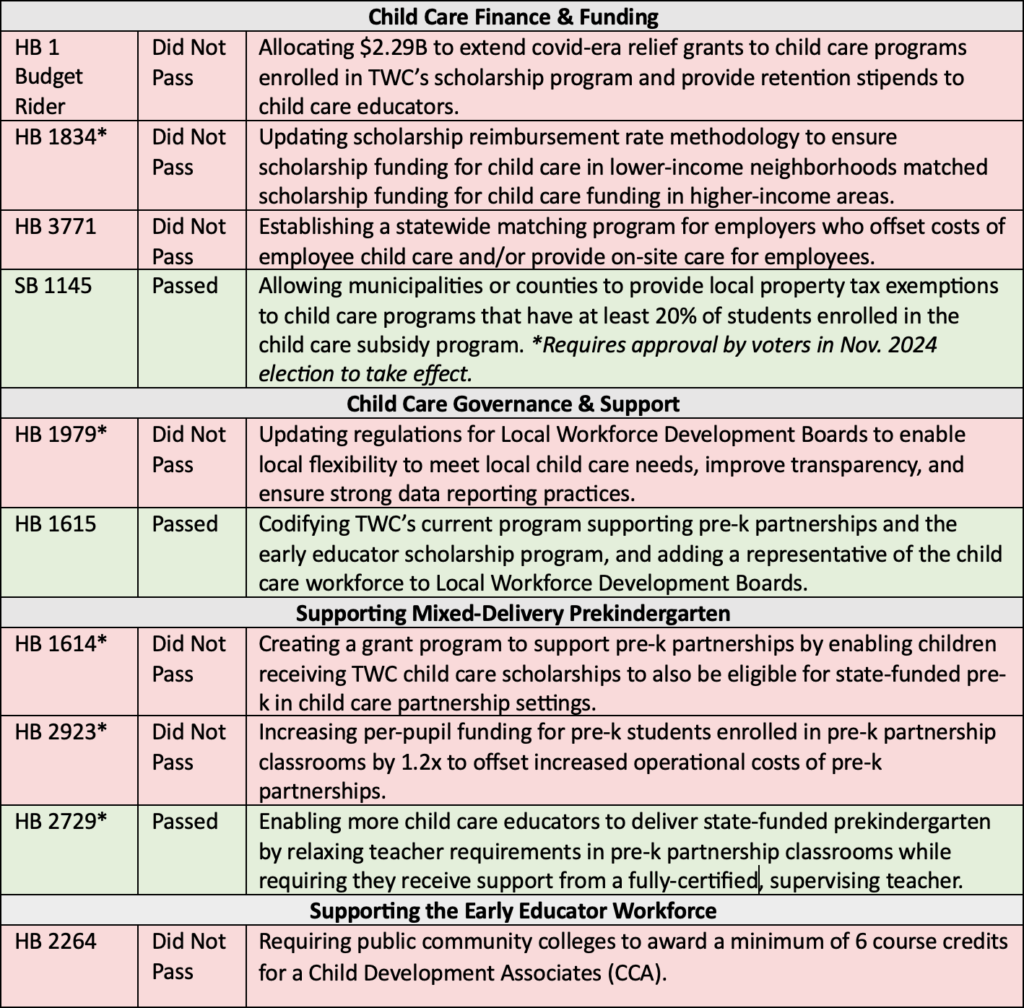Catherine Davis | 08.07.2023
88th Legislative Session: A Lack-Luster Session for Child Care. Now What?
With Texas’ 88th legislative session behind us, we wanted to take a moment to reflect on the outcomes, and our own lessons learned relative to advancing strong policy solutions for child care. With a nearly $33B surplus at the state and unprecedented public attention on the importance of child care, many were hopeful that this would be the flashpoint opportunity needed to revive the system. Although there were some incremental policy wins this session, the overall outcome fell far short of the systemic turnaround so desperately needed.
This marked the first year that Child Care Associates engaged actively during the legislative process after recognizing the need to bring more on-the-ground voices to our statewide early learning policy discussions. The many organizations and individuals with whom we worked this session represented a diversity of perspectives, often covering a multitude of issues beyond early learning. As a child care operator and a local ECE systems-leader, we worked alongside statewide advocates to provide a unique perspective—surfacing lived challenges with the system and bringing forward community proof points to guide solutions and build a shared legislative agenda.
So, what was accomplished in this session and what proposals fell short? But more importantly, what can we learn from the way things played out and how can child care advocates become better positioned to achieve meaningful policy wins in future sessions?
Outcomes From 2022 Legislative Session
This year there was an unprecedented 60+ child care-related bills filed in the legislature, underscoring the attention and will to revive the system. Below is an overview of how CCA’s priority legislation(*) and other notable bills fared. Read more about Child Care Associates’ 2023 legislative priorities, here.
The few bills that passed this session each have the potential to create incremental progress; however, it is evident that we fell short of any real transformative change. So, as the need to dramatically rethink and redesign our 0-5 early learning system remains, where do we go from here? What learnings can we draw out and how might we utilize them to regain the momentum needed to do so?
Lessons Learned & Reflections on Where to Go from Here
Lesson #1 – Child Care Needs New Policy Solutions
- Bipartisan Solutions. We learned this session that child care is a bipartisan issue. However, to secure more champions, policy solutions need to feel exciting and transformative, while remaining easy to understand and connect to. Particularly for Texas’ many conservative policymakers, solutions need to feel self-sustaining and fiscally neutral. Conversations around more resources for child care also need to include solutions that fundamentally change the way resources are used, rather than continuing to pour resources into a broken system. Securing more bipartisan requires us to be more intentional about bringing policymakers from both parties to the table to ideate new solutions and co-create a shared vision for change.
- Community-Driven Solutions. In a state as big as Texas, we see incredible innovation & systems-redesign efforts happening in local communities across the state. To truly strengthen our statewide early learning system, we must ensure policy solutions are rooted in proof points (good or bad) from the realities on-the-ground. This will require a stronger ladder from the “grassroots to the grasstops”, as well as ensuring local systems leaders are equitable partners in state-level policy creation. Read more: The Power of Community Voice in TX
- Intersectional Solutions. For decades, child care has been perceived as a siloed cause. In recent years, researchers and advocates have started to broaden the narrative, linking child care to educational outcomes, workforce outcomes, the economy, family flourishing, child health, etc. This has been an effective strategy for increasing public attention, but creating policy change will require taking it a step further. This means exploring actual policy solutions—not just messages—that tangibly reflect this intersectionality. By co-creating policy solutions alongside advocates for these tangential causes, child care has the opportunity to ride on the coattails of those with already strong policy momentum (e.g., health, economic prosperity, family choice). This is likely to increase the pool of support and the likelihood of success.
Lesson #2 – Child Care Needs a Convergence – Internally & Externally
- Reconcile Competing Perspectives to Hone a Compelling Message. A recent op-ed on the medium Vox suggested that child care is in the midst of an identity crisis. It pointed out that—when talking about “the child care crisis”– not everybody is talking about the same thing. Depending on who you talk to, “the crisis” might be one of parent affordability, or lack of high-quality seats. Lack of parent choice or the constant turnover of early educators due to sub-poverty wages. To others, it’s an economic crisis, keeping parents, mostly women, out of the workforce. Many believe it’s a crisis of educational inequity. It’s fair to say most advocates and policymakers in Texas recognize all of these as legitimate. However, this session surfaced a lack of consensus over where to prioritize, creating some confusion and misalignment within the movement that likely diluted the collective results. Before moving forward, advocates and stakeholders must take time to unpack these varying perspectives and priorities, understand whom they are coming from and what experiences led them there, and be willing to challenge our own perspectives. By driving greater understanding and respect for the many divergent priorities under the “child care crisis” umbrella, we can start to unstick areas of difference, pinpoint (and articulate) which elements of the crisis we aim to solve together and which elements we do not, and ultimately hone a more compelling message as a coalition.
- Rally Demand from Outside the Field. As mentioned previously, the child care crisis overlaps with several tangential issue areas that benefit from a broad base of recognition and support (e.g., economic prosperity, education, health, family choice, and the environment). At the same time that child care advocates are exploring and reconciling the many competing perspectives from within our own movement, we should also work intentionally to rally demand for child care amongst those from other related causes. This means working alongside leaders of other coalitions to understand their goals, identify converging priorities, co-create intersectional policy solutions and, ultimately, messaging campaigns that drive, rather than assume, demand across multiple sectors.
Lesson #3 – Child Care Needs a Long-Term Strategy, Backed with Short Term Goals & Commitments
- Unfortunately, the “child care system” today remains an “un-system.” Never intentionally designed, child care in Texas has been piecemealed together, spread across several other “systems” and agencies. Despite several well-meaning yet incremental tweaks and improvements to this “un-system” over time, most agree that the time is ripe for a system (re)design. Systems transformations are often difficult and clunky undertakings that require a clear and unwavering commitment to the long game. Therefore, before setting any sort of system redesign in motion, policymakers, advocates and key stakeholders should work together to align on the following questions fundamental to achieving long-term success:
- What is our collective, long-term vision?
- What are the key barriers to that long-term vision today?
- What are the “winnable” milestones that track towards that vision?
- What interventions can we agree on today that are better than the status quo and dismantle key barriers?
- Arguably, the first two questions will be the most challenging, as they require those of us involved to work through many of our own sticking points and competing perspectives. Identifying a common “big vision” is one thing, but determining where and how the rubber hits the road is another. Aligning on which “winnable” milestones to work towards requires an even deeper level of consensus on the long-term strategy. Just as agreeing on which interventions to pursue today—that may not be perfect, but exceed the status quo—requires a common trust that we’re all working towards the same long-term vision.


